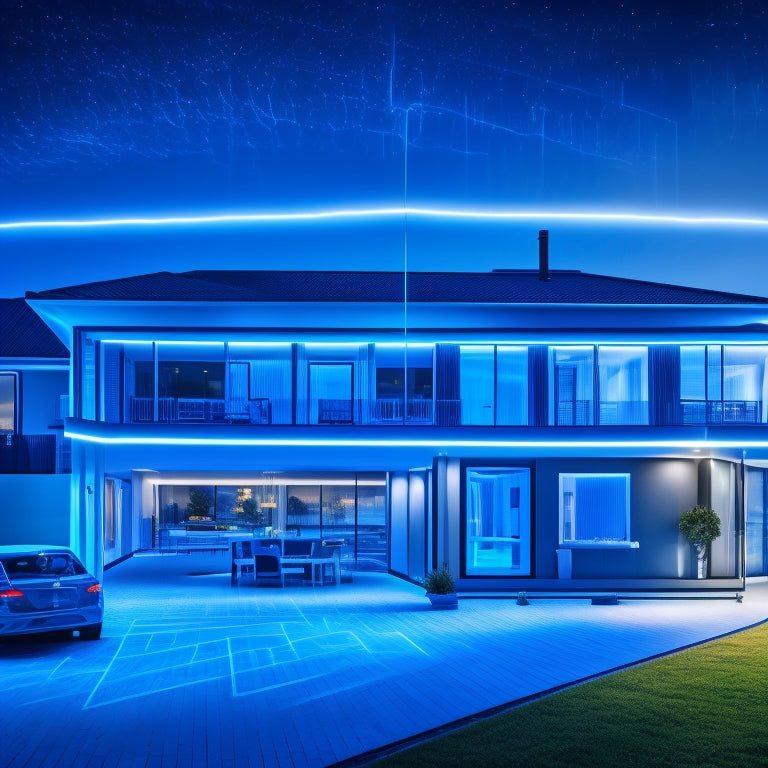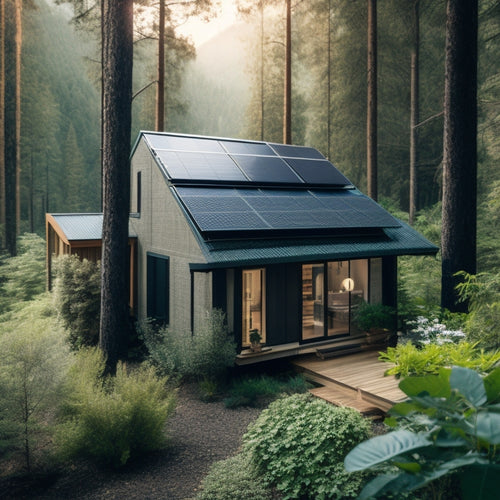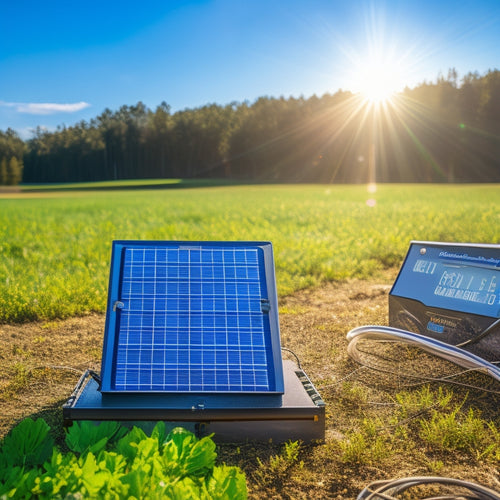
What's the Cost of Home Energy Monitoring?
Share
When considering a home energy monitoring system, you'll need to factor in several costs, including the upfront expense of hardware and installation, which can vary depending on your home's electrical system and the complexity of the setup. Ongoing subscription fees, software costs, and additional sensor or device expenses will also add to your overall cost. Moreover, professional installation is essential for accurate system setup, and this will come at a cost. While it may seem like a significant investment, a well-designed system can help you identify areas for energy savings, and understanding these costs is vital to making an informed decision – and that's just the beginning.
Overview
- Energy monitoring systems often require a recurring subscription, with costs varying based on the provider and level of service.
- The cost of energy monitoring software can range from free to several hundred dollars annually, depending on features and data analysis capabilities.
- Additional sensors and devices can provide more detailed insights, but may add to the overall cost, with prices varying depending on type and compatibility.
- Professional installation is highly recommended to ensure accurate setup and may be required to validate manufacturer warranties, with costs varying depending on location and provider.
- The total cost of home energy monitoring will depend on the specific system, software, and features chosen, as well as any additional devices or services.
System Hardware and Installation
When it comes to home energy monitoring, system hardware and installation play an important role in accurately tracking your energy consumption.
You'll need to take into account the type of hardware that's compatible with your home's electrical system. Verify that the system you choose is compatible with your electrical panel and can handle the voltage and current of your home.
A user-friendly interface is also significant, as it'll make it easy for you to understand your energy usage patterns. When selecting a system, think about opting for advanced battery systems that can detect and store excess energy from renewable sources, allowing you to optimize your energy consumption.
A well-designed interface will provide you with clear, actionable observations, equipping you to make informed decisions about your energy consumption.
A professional installation will guarantee the system is set up correctly, providing accurate readings and reliable performance.
Ongoing Subscription and Fees
Energy monitoring systems often come with ongoing subscription and fee structures that can add to their overall cost. When you're considering a system, you'll want to factor in these recurring expenses to get an accurate representation of the total cost of ownership.
Implementing energy-saving strategies, such as those found in energy assessment and needs analysis, can help reduce energy consumption and lower costs.
Subscription models can vary widely, with some providers charging a flat monthly or annual fee, while others may charge based on the amount of data you use or the number of sensors you have installed.
Be sure to do a cost comparison to determine which option is the most cost-effective for your needs. Some providers may also charge extra for premium features, data analytics, or customer support, so be sure to factor those in as well.
Energy Monitoring Software Costs
Many energy monitoring systems rely on sophisticated software to collect, analyze, and present your energy usage data. This software is often the backbone of your energy monitoring system, providing you with useful observations to optimize your energy consumption and maximize energy savings.
Real-time performance monitoring systems enable identification of potential issues before escalation, and advanced data analytics platforms facilitate optimization of energy yield in renewable energy systems.
You'll typically access this software through a web portal or mobile app, where you can view real-time energy usage data, set alerts, and receive personalized recommendations for reducing your energy footprint.
The cost of this software can vary widely, ranging from free to several hundred dollars per year, depending on the level of features and functionality you require.
When evaluating energy monitoring software, consider the user experience, data accuracy, and customization options to guarantee you're getting the most benefit for your money.
Additional Sensor and Device
Your energy monitoring system may require additional sensors and devices to capture a more detailed overview of your energy usage.
These sensors can provide granular data on specific aspects of your energy consumption, such as water or gas usage. You may need to purchase additional sensors, like whole-home sensors, plug-in sensors, or smart outlets, to gain a more extensive understanding of your energy habits.
Verify that these devices are compatible with your energy monitoring system and can integrate seamlessly.
Various sensor types, including Wi-Fi, Zigbee, or Z-Wave, offer different connectivity options.
When selecting additional devices, consider factors like device compatibility, sensor accuracy, and data reliability to verify a cohesive and effective energy monitoring system.
Professional Installation Options
Upon deciding to invest in a home energy monitoring system, you'll need to assess the importance of professional installation options.
While a DIY installation may seem like a cost-effective solution, it can lead to incorrect setup, inaccurate readings, and even safety hazards.
Professional installation, on the other hand, offers several benefits. Trained technicians will guarantee that your system is installed correctly, configured properly, and integrated with existing infrastructure. This results in accurate energy monitoring, optimized energy efficiency, and enhanced safety.
Additionally, many manufacturers require professional installation to validate warranties, providing you with peace of mind and protection for your investment.
Considering the costs and benefits, professional installation may be a worthwhile investment for a reliable and efficient home energy monitoring system.
Frequently Asked Questions
Can I Use Home Energy Monitoring With My Existing Smart Home System?
You can integrate home energy monitoring with your existing smart home system, but be prepared to tackle smart home compatibility and potential integration challenges, ensuring seamless data exchange and control.
Will Energy Monitoring Systems Work With Renewable Energy Sources Like Solar?
Ha! You think the energy grid cares about your eco-friendly vibes? Nope, but seriously, you'll be thrilled to know that most energy monitoring systems seamlessly integrate with solar panels, tracking your energy efficiency and optimizing your green energy output.
How Does Home Energy Monitoring Impact My Home's Resale Value?
When you invest in home energy monitoring, you're enhancing your home's energy efficiency, which translates to significant resale advantages, increasing your property's value and appeal to potential buyers who crave freedom from high energy bills.
Are Home Energy Monitoring Systems Compatible With All Types of Appliances?
You'll find that most home energy monitoring systems are compatible with various appliances, but it depends on the type of energy monitoring: whole-home, circuit-level, or device-level, and the appliance's communication protocol, such as Zigbee or Wi-Fi.
Do Energy Monitoring Systems Provide Real-Time Energy Usage Data?
As you explore the world of energy monitoring, you'll find that systems providing real-time usage data are like having a crystal ball, offering unparalleled data accuracy and a user-friendly interface that enables you to take control of your energy freedom.
Ready to Buy
You've invested in a home energy monitoring system, thinking you're saving money, but have you factored in the hidden costs? The irony is that you're paying to know how much you're paying. From system hardware and installation to ongoing subscription fees, energy monitoring software costs, and additional sensor devices, the expenses add up. And if you opt for professional installation, that's another bill to foot. It's like trying to hold water in your hand - the more you squeeze, the more it slips through your fingers.
Related Posts
-

Key Components of a Reliable Emergency Power Supply System
A reliable emergency power supply system requires several key components. You need proven performance metrics to guar...
-

Off Grid Solar Batteries
As you shift to off-grid living, you'll rely on high-performance solar batteries to store excess energy generated by ...
-

Choosing the Right Solar Power Charge Controller
Choosing the right solar power charge controller is crucial for maximizing energy efficiency and extending battery li...


